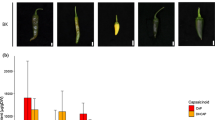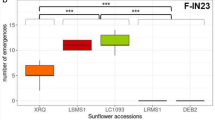Abstract
Pod dehiscence is a key trait in legumes due to its relevance for seed dispersal and yield losses. Although transcriptional networks controlling dehiscence have been well explored in cereal crops and models, such as Arabidopsis, our knowledge on molecular control of the trait in legumes is relatively limited. In chickpea (Cicer arietinum L.), the identification of major and minor genes controlling pod dehiscence is very important when wild genotypes are used to introgress germplasm in cultivated ones. In this study, we characterized phenotypically a RIL population from an interspecific cross and used a candidate gene approach to identify orthologous to dehiscence-related genes. The segregation pattern in the RIL population suggests that the trait is under oligogenic control. Through genome mapping and sequencing, we developed DNA markers and identified the PDH1 gene as an important regulator of pod shattering in chickpea. Our results may help the exploitation of wild germplasm resources in chickpea breeding programs and shed light on the relationships between the molecular and phenotypic variations in this important legume species.



Similar content being viewed by others
References
Abbo S, Berger J, Turner NC (2003) Viewpoint: evolution of cultivated chickpea: four bottlenecks limit diversity and constrain adaptation. Functional Plant Biol 30:1081. https://doi.org/10.1071/FP03084
Ballester P, Ferrándiz C (2017) Shattering fruits: variations on a dehiscent theme. Curr Opin Plant Biol 35:68–75. https://doi.org/10.1016/j.pbi.2016.11.008
Christiansen LC, Dal Degan F, Ulvskov P, Borkhardt B (2002) Examination of the dehiscence zone in soybean pods and isolation of a dehiscence-related endopolygalacturonase gene. Plant Cell Environ 25:479–490. https://doi.org/10.1046/j.1365-3040.2002.00839.x
Cobos MJ, Rubio J, Strange RN et al (2006) A new QTL for Ascochyta blight resistance in an RIL population derived from an interspecific cross in chickpea. Euphytica 149:105–111. https://doi.org/10.1007/s10681-005-9058-3
Croser JS, Ahmad F, Clarke HJ, Siddique KHM (2003) Utilisation of wild Cicer in chickpea improvement — progress, constraints, and prospects. Aust J Agric Res 54:429. https://doi.org/10.1071/AR02157
Dardick C, Callahan AM (2014) Evolution of the fruit endocarp: molecular mechanisms underlying adaptations in seed protection and dispersal strategies. Front Plant Sci 5:284. https://doi.org/10.3389/fpls.2014.00284
Development Core Team R (2018) R: a language and environment for statistical computing. R Foundation for Statistical Computing, Vienna
Di Vittori V, Gioia T, Rodriguez M et al (2019) Convergent evolution of the seed shattering trait. Genes (Basel). https://doi.org/10.3390/genes10010068
Die JV (2018) refseqR : Common computational operations working with GenBank. Zenodo doi:https://doi.org/10.5281/zenodo.1188462
Doebley JF, Gaut BS, Smith BD (2006) The molecular genetics of crop domestication. Cell 127:1309–1321. https://doi.org/10.1016/j.cell.2006.12.006
Dong Y, Yang X, Liu J et al (2014) Pod shattering resistance associated with domestication is mediated by a NAC gene in soybean. Nat Commun 5:3352. https://doi.org/10.1038/ncomms4352
FAOSTAT (2017) Crop statistics. Available on line: http://www.fao.org/faostat (accessed Jul 14, 2019)
Ferrándiz C, Liljegren SJ, Yanofsky MF (2000, Science) Negative regulation of the SHATTERPROOF genes by FRUITFULL during Arabidopsis fruit development. 289:436–438. https://doi.org/10.1126/science.289.5478.436
Funatsuki H, Suzuki M, Hirose A, Inaba H, Yamada T, Hajika M, Komatsu K, Katayama T, Sayama T, Ishimoto M, Fujino K (2014) Molecular basis of a shattering resistance boosting global dissemination of soybean. Proc Natl Acad Sci U S A 111:17797–17802. https://doi.org/10.1073/pnas.1417282111
Hammer K (1984) Das Domestikationssyndrom. Die Kulturpflanze 32:11–34. https://doi.org/10.1007/BF02098682
Jain M, Misra G, Patel RK et al (2013) A draft genome sequence of the pulse crop chickpea (Cicer arietinum L.). Plant J 74:715–729. https://doi.org/10.1111/tpj.12173
Kosambi DD (1943) The estimation of map distances from recombination values. Ann Eugenics 12:172–175. https://doi.org/10.1111/j.1469-1809.1943.tb02321.x
Ladizinsky G (1979) Seed dispersal in relation to the domestication of Middle East legumes. Econ Bot 33:284–289. https://doi.org/10.1007/BF02858256
Lamprecht H (2010) BEITRÄGE ZUR GENETIK VON PHASEOLUS VULGARIS. Hereditas 16:169–211. https://doi.org/10.1111/j.1601-5223.1932.tb02567.x
Li LF, Olsen KM (2016) To have and to hold: selection for seed and fruit retention during crop domestication. Curr Top Dev Biol 119:63–109. https://doi.org/10.1016/bs.ctdb.2016.02.002
Meakin PJ, Roberts JA (1990a) Dehiscence of fruit in oilseed rape (Brassica napus L.). J Exp Bot 41:1003–1011. https://doi.org/10.1093/jxb/41.8.1003
Meakin PJ, Roberts JA (1990b) Dehiscence of fruit in oilseed rape (Brassica napus L.). J Exp Bot 41:995–1002. https://doi.org/10.1093/jxb/41.8.995
Meyer RS, Purugganan MD (2013) Evolution of crop species: genetics of domestication and diversification. Nat Rev Genet 14:840–852. https://doi.org/10.1038/nrg3605
Millan T, Winter P, Jüngling R et al (2010) A consensus genetic map of chickpea (Cicer arietinum L.) based on 10 mapping populations. Euphytica 175:175–189. https://doi.org/10.1007/s10681-010-0157-4
Millán T, Madrid E, Castro P et al (2017) Genetic mapping and quantitative trait loci. In: Varshney RK, Thudi M, Muehlbauer F (eds) The chickpea genome. Springer International Publishing, Cham, pp 83–106
Murgia ML, Attene G, Rodriguez M, Bitocchi E, Bellucci E, Fois D, Nanni L, Gioia T, Albani DM, Papa R, Rau D (2017) A comprehensive phenotypic investigation of the “pod-shattering syndrome” in common bean. Front Plant Sci 8:251. https://doi.org/10.3389/fpls.2017.00251
Paniagua C, Bilkova A, Jackson P, Dabravolski S, Riber W, Didi V, Houser J, Gigli-Bisceglia N, Wimmerova M, Budínská E, Hamann T, Hejatko J (2017) Dirigent proteins in plants: modulating cell wall metabolism during abiotic and biotic stress exposure. J Exp Bot 68:3287–3301. https://doi.org/10.1093/jxb/erx141
Parween S, Nawaz K, Roy R et al (2015) An advanced draft genome assembly of a desi type chickpea (Cicer arietinum L.). Sci Rep 5:12806. https://doi.org/10.1038/srep12806
Rajani S, Sundaresan V (2001) The Arabidopsis myc/bHLH gene ALCATRAZ enables cell separation in fruit dehiscence. Curr Biol 11:1914–1922. https://doi.org/10.1016/S0960-9822(01)00593-0
Rau D, Murgia ML, Rodriguez M, Bitocchi E, Bellucci E, Fois D, Albani D, Nanni L, Gioia T, Santo D, Marcolungo L, Delledonne M, Attene G, Papa R (2019) Genomic dissection of pod shattering in common bean: mutations at non-orthologous loci at the basis of convergent phenotypic evolution under domestication of leguminous species. Plant J 97:693–714. https://doi.org/10.1111/tpj.14155
Ripoll JJ, Roeder AHK, Ditta GS, Yanofsky MF (2011) A novel role for the floral homeotic gene APETALA2 during Arabidopsis fruit development. Development 138:5167–5176. https://doi.org/10.1242/dev.073031
Roberts JA, Elliott KA, Gonzalez-Carranza ZH (2002) Abscission, dehiscence, and other cell separation processes. Annu Rev Plant Biol 53:131–158. https://doi.org/10.1146/annurev.arplant.53.092701.180236
Sehra B, Franks RG (2017) Redundant CArG box cis-motif activity mediates SHATTERPROOF2 transcriptional regulation during Arabidopsis thaliana gynoecium development. Front Plant Sci 8:1712. https://doi.org/10.3389/fpls.2017.01712
Shapiro SS, Wilk MB (1965) An analysis of variance test for normality (complete samples). Biometrika 52:591. https://doi.org/10.2307/2333709
Singh RP, Mujeeb-Kazi A, Huerta-Espino J (1998) Lr46: a gene conferring slow-rusting resistance to leaf rust in wheat. Phytopathology 88:890–894. https://doi.org/10.1094/PHYTO.1998.88.9.890
Suanum W, Somta P, Kongjaimun A, Yimram T, Kaga A, Tomooka N, Takahashi Y, Srinives P (2016) Co-localization of QTLs for pod fiber content and pod shattering in F2 and backcross populations between yardlong bean and wild cowpea. Mol Breeding 36:80. https://doi.org/10.1007/s11032-016-0505-8
Suzuki M, Fujino K, Funatsuki H (2009) A major soybean QTL, qPDH1, controls pod dehiscence without marked morphological change. Plant Prod Sci 12:217–223. https://doi.org/10.1626/pps.12.217
Tang H, Cuevas HE, Das S, Sezen UU, Zhou C, Guo H, Goff VH, Ge Z, Clemente TE, Paterson AH (2013) Seed shattering in a wild sorghum is conferred by a locus unrelated to domestication. Proc Natl Acad Sci U S A 110:15824–15829. https://doi.org/10.1073/pnas.1305213110
Van Gastel A (2007) Chickpea seed production. Chickpea Breedingand Management. pp 417–444
Van Ooijen JW (2006) JoinMap® 4, Software for the calculation of genetic linkage maps in experimental populations. Kyazma BV, Wageningen, 33 33:4
Varshney RK, Song C, Saxena RK et al (2013) Draft genome sequence of chickpea (Cicer arietinum) provides a resource for trait improvement. Nat Biotechnol 31:240–246. https://doi.org/10.1038/nbt.2491
Varshney RK, Thudi M, Roorkiwal M, He W, Upadhyaya HD, Yang W, Bajaj P, Cubry P, Rathore A, Jian J, Doddamani D, Khan AW, Garg V, Chitikineni A, Xu D, Gaur PM, Singh NP, Chaturvedi SK, Nadigatla GVPR, Krishnamurthy L, Dixit GP, Fikre A, Kimurto PK, Sreeman SM, Bharadwaj C, Tripathi S, Wang J, Lee SH, Edwards D, Polavarapu KKB, Penmetsa RV, Crossa J, Nguyen HT, Siddique KHM, Colmer TD, Sutton T, von Wettberg E, Vigouroux Y, Xu X, Liu X (2019) Resequencing of 429 chickpea accessions from 45 countries provides insights into genome diversity, domestication and agronomic traits. Nat Genet 51:857–864. https://doi.org/10.1038/s41588-019-0401-3
Vaughan DA, Balázs E, Heslop-Harrison JS (2007) From crop domestication to super-domestication. Ann Bot 100:893–901. https://doi.org/10.1093/aob/mcm224
Weeden NF, Brauner S, Przyborowski JA (2002) Genetic analysis of pod dehiscence in pea (Pisum sativum L.). Cell Mol Biol Lett 7:657–663
Yoon J, Choi H, An G (2015) Roles of lignin biosynthesis and regulatory genes in plant development. J Integr Plant Biol 57:902–912. https://doi.org/10.1111/jipb.12422
Acknowledgments
Authors thank the assistance provided by Jaqueline Ghysbrecht Ríos on phenotypic data collection.
Funding
This work has been supported by INIA Project RTA2017-00041 (co-financed by the European Union through the ERDF2014–2020 “Programa Operativo de Crecimiento Inteligente”) and PP.AVA.AVA2019.030. DAB has his Ph.D. fellowship INIA-CCAA. JVD and PC are supported by the “Plan Propio de Investigación de la Universidad de Córdoba” and the EU “Programa Operativo de fondos FEDER Andalucía.”
Author information
Authors and Affiliations
Contributions
Conceptualization: TM and JG; Methodology: DAB, JR; Formal analysis and investigation: DAB, JVD, PC; Writing - original draft preparation: DAB, JVD, PC; Writing - review and editing: JG, JVD, PC; Funding acquisition: TM and JR; Supervision: JVD and PC.
Corresponding author
Additional information
Publisher’s note
Springer Nature remains neutral with regard to jurisdictional claims in published maps and institutional affiliations.
Rights and permissions
About this article
Cite this article
Aguilar-Benitez, D., Rubio, J., Millán, T. et al. Genetic analysis reveals PDH1 as a candidate gene for control of pod dehiscence in chickpea. Mol Breeding 40, 40 (2020). https://doi.org/10.1007/s11032-020-01117-9
Received:
Accepted:
Published:
DOI: https://doi.org/10.1007/s11032-020-01117-9




